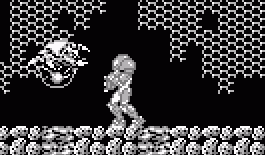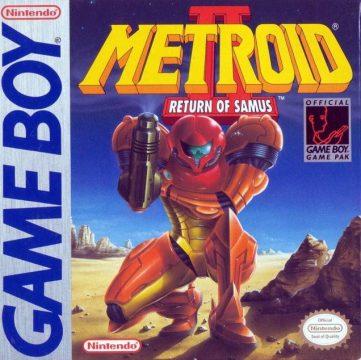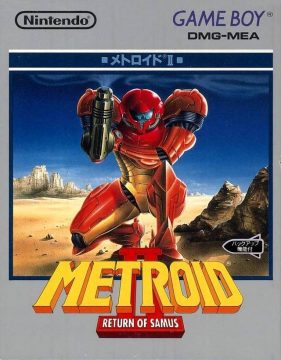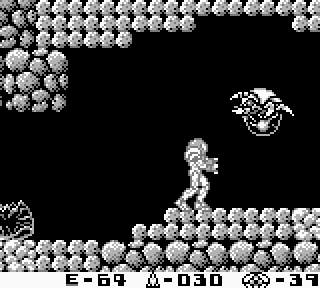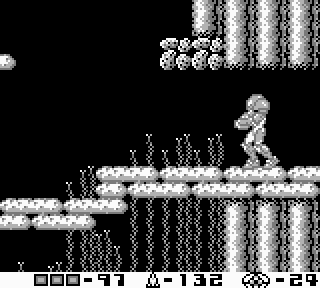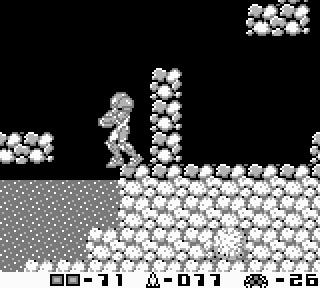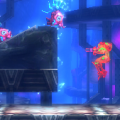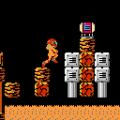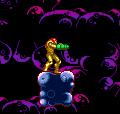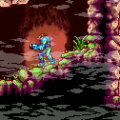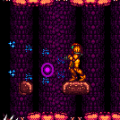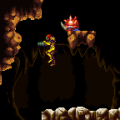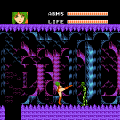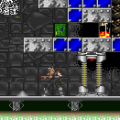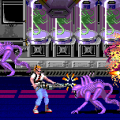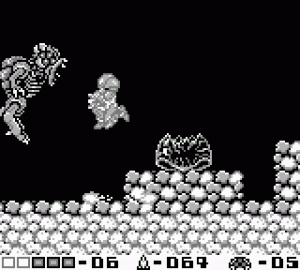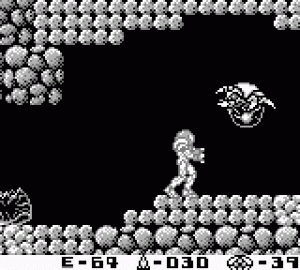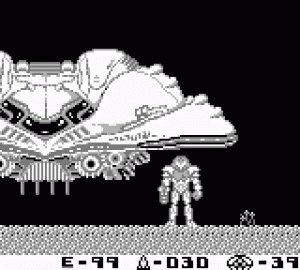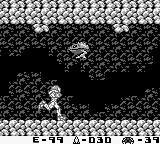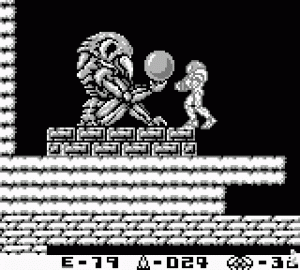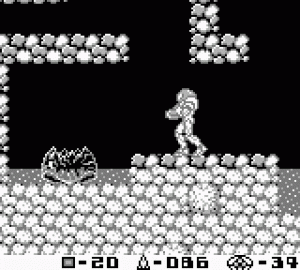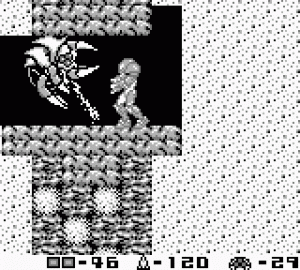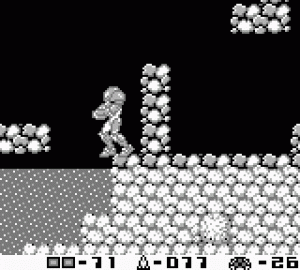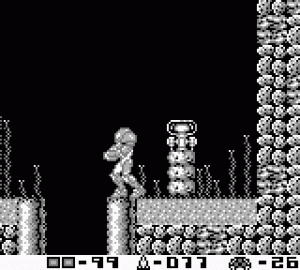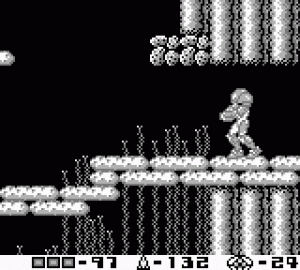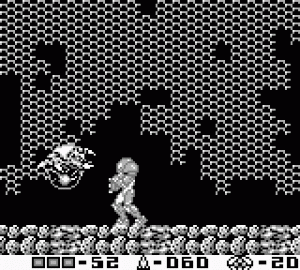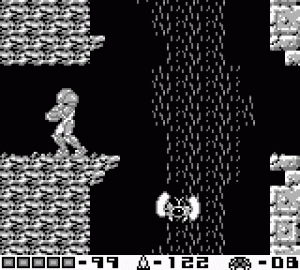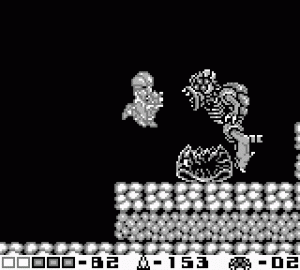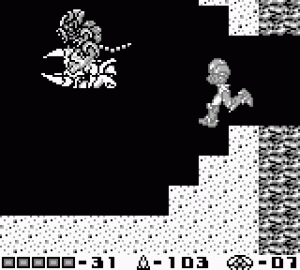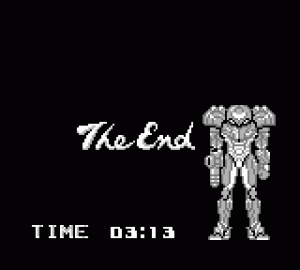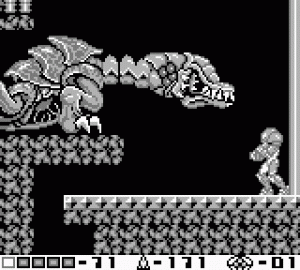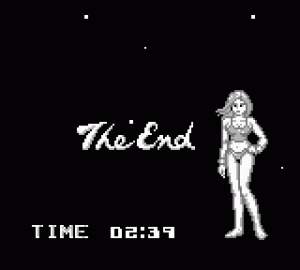Rather than directly converting their NES and SNES games, Nintendo made it a habit to create unique entries of their popular franchises, like Super Mario Land and The Legend of Zelda: Link’s Awakening. Metroid II: Return of Samus falls into that category as well, iterating greatly on the original game despite the lesser Game Boy hardware.
As the introduction to the original relates, the Metroid samples were stolen by the Space Pirates from their home planet, called SR388. In order to put an end to this, Samus is set directly to the desolate world to hunt and destroy every last one of them. What we learn in this game is that the Metroids we saw originally were just in a larval stage, and once they grow old enough, they transform into something more terrifying. Indeed, every Metroid you fight here is actually evolved into a completely different form, divided into four categories: Alpha, Gamma, Zeta, and Omega. In their Alpha state, they won’t do much more than fly around and attack, but both their size and abilities grow more advanced in the later forms.
Metroid II makes some small advancements over its predecessor. Samus’ sprite is larger, and her power suit, as seen on the cover, has been redesigned into the style that was used in later entries. She can kneel and shoot downwards now, and actually starts off with both the Morph Ball (Maru Mari) and a small collection of missiles. It utilizes a save system, with regular save points, as well as periodic stops where you can refill your health and missiles. Samus’ iconic ship, with its design loosely based on the power suit’s helmet, also makes it first appearance here. The screen is no longer restricted to just scrolling horizontally or vertically, allowing for larger rooms and more elaborate level designs.
Samus’ arsenal has also been expanded considerably. The Spring Ball lets you jump in ball form (no more bomb jumping!) while the Spider Ball lets you attach yourself to most walls or ceilings and roll along it. The Space Jump lets Samus repeatedly jump in mid-air, effectively allowing her to fly, as long as you get the timing down. There are a few new weapons, including the Spazer Lazer, which shoots three small lasers in a wide pattern, and the Plasma laser, which is more focused but also much more powerful. The Ice Beam isn’t as important this time around, since it no longer works on evolved Metroids anyway – the only things that will work are missiles, so it’s even more important to both conserve them and hunt for more canisters.
The levels have also been restructured to be a little more linear. As you explore the caverns of SR388, you’ll occasionally come across pools of hazardous liquid, which blocks from progressing deeper into the planet. There’s a little indicator that shows how many Metroids are left to kill in the game – once you destroy all of them within a given area, an earthquake will be triggered and the liquid will disappear, allowing you to backtrack and continue downwards. The only indicator that you’re close to a Metroid is their abandoned shell, sending your senses racing until you find it. It’s legitimately terrifying when you come across one and it’s the first one to evolve into a more powerful form, one which you might not be ready to tackle.
The restrictive approach to level design has both its positives and negatives. On one hand, it lets you focus on looking in a specific area, rather than needing to comb the entire game world for any remaining Metroids. On the other hand, many of the Metroids are still hidden, and with the existence of items like the Spider Ball, you’re required to not only test every wall and floor, but also roll along everything to check for hidden stuff on the ceilings too. Some areas are filled with sand too, which you must destroy block-by-block.
This is only one aspect that makes Metroid II even more tedious than the original. The larger sprite makes Samus easier to see, especially against the dark background, but it also makes the screen feel more cramped, and it’s hard to get a grasp on what’s around you. The monochrome backgrounds don’t do the game any favors either – even though the original game was rather repetitive, there were still many distinctive areas, in both design and color. Here, it’s just caves and more caves, and even though the background tiles are a little different, without any color, they still lack variety. Technically the game is divided into areas by the liquid, but there’s not much visual distinction between them, and outside of the Metroids (and one optional boss fight), there aren’t any other bosses. Plus, given that the level layouts don’t adhere to an mappable grid like its predecessor, it makes navigating even more haphazard. Once again, there’s no automap either, so using a strategy guide (especially one of the printed ones from Nintendo Power) makes playing the game much easier. There are also more weapons than before, but still no way to switch them without backtracking and picking one up again.
The final boss battle against the Queen Metroid is also incredibly difficult, even more so than the Mother Brain fight. It takes about 150 missiles to kill, though there are some alternate strategies, including getting into the queen’s mouth and bombing it from within its stomach, which will do some extra damage. Either way, you’ll definitely need to have found enough missiles canisters or energy tanks to make it beatable.
There are only a few pieces of music found throughout – the surface theme is quite catchy, but the rest are harsh and dissonant, especially coming out of the Game Boy’s sound chip. But it does create a harsh aural atmosphere, something which works in the game’s favor, providing your ears can take it.
And that’s the general takeaway from the entirety of Metroid II. Much like the original game, it’s a harsh and frightening game, as you scramble around seemingly endless tunnels, digging deeper into a cavern filled with unknown terrors, all while hoping to just get some grasp on where you are and where you’re supposed to be going. It’s incredible that such a deep, expansive world could be kept on a tiny cartridge, on a system that could be stored away in your backpack. And while it does grow tedious if you play it in long stretches, there is something satisfying about seeing the Metroid counter tick down by one each time you kill them, and it feels like a huge undertaking once you’ve whittled it down to the single digits. Plus, between the original and the later games, the antagonists are technically other forces (like the Space Pirates) utilizing the powers of the Metroids for their own ends. Here, the Metroids, fearsome and ever evolving, being wild creatures that care just for their survival and procreation, are the only real enemies.
The best moments come at the end, where the Metroid counter is at one, and you think you might be coming upon the final encounter…only for Samus to discover an egg, which immediately hatches, and the Metroid counter ticks up to nine. These are actually the only “original” Metroids found in the game, compared to the evolved forms you fight elsewhere in the game, though once you’ve got the Ice Beam, they’re easily disposed of. It’s also unusual in that it doesn’t end in a timed escape sequence, like other Metroid games. Indeed, once you beat the Queen Metroid, a little baby Metroid hatches, and mistakes Samus for her mother, causing her to spare its life and instead care for it. The trip back to the surface, with the baby Metroid nipping at Samus’ heels and clearing otherwise impassable obstacles for her, is surprisingly calm and stress relieving, as that kind gesture from Samus will eventually set off the story for the next game.
Metroid II makes some significant advancements over its predecessor, and creates a structure that both expands on the series’ lore and makes it distinctive, even among later Metroid games. But at the same time, the limitations of the platform really hold it back, so it’s aged even more harshly than the original. The fact that it’s been remade twice (officially and unofficially) make it difficult to return to, unless you have a very specific affinity to navigating terrifying-but-monotonous tunnels.
There were plans for a “DX” version of Metroid II, similar to Link’s Awakening, which would have supported larger colors palettes for the Game Boy Color. However, the release was canceled.
Links
http://metroid.retropixel.net/ – Screens from here.
